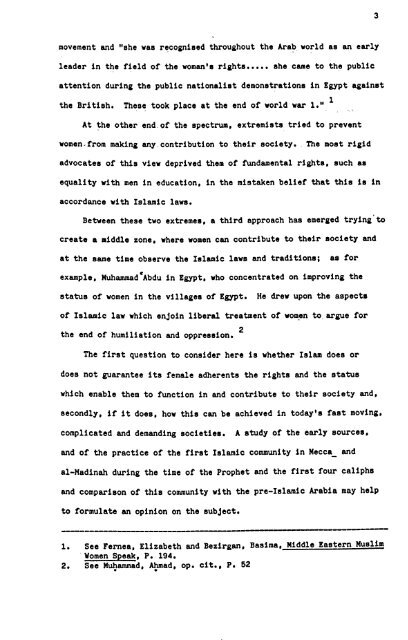Download - University of Salford Institutional Repository
Download - University of Salford Institutional Repository
Download - University of Salford Institutional Repository
Create successful ePaper yourself
Turn your PDF publications into a flip-book with our unique Google optimized e-Paper software.
movement and "she was recognised throughout the Arab, world as an early<br />
leader in the field <strong>of</strong> the woman's rights ..... she came to the public<br />
attention during the public nationalist demonstrations in Egypt against<br />
the British. These took place at the end <strong>of</strong> world war 1.11 1<br />
At the other end. <strong>of</strong> the spectrum, extremists tried to prevent<br />
women-from making any. contribution to their society., The most rigid<br />
advocates <strong>of</strong> this view deprived them <strong>of</strong> fundamental rights, such as<br />
equality with men in education. in the mistaken belief that this is in<br />
accordance with Islamic laws.<br />
Between these two extremes, a third approach has emerged trying to<br />
create a middle zone, where women can contribute to their society and<br />
at the same time observe the Islamic laws and traditions; as for<br />
example, MuhammadcAbdu in Egypt. who concentrated on improving the<br />
status <strong>of</strong> women in the villages <strong>of</strong> Egypt. He draw upon the aspects<br />
<strong>of</strong> Islamic law which enjoin liberal treatment <strong>of</strong> women to. argue for<br />
the end <strong>of</strong> humiliation and oppression.<br />
The first question to consider here is whether Islam does or<br />
does not guarantee its female adherents the rights and the status<br />
which enable them to function in and contribute to their society and,<br />
secondly, if it does, how this can be achieved in today's fast moving.<br />
complicated and demanding societies. A study <strong>of</strong> the early sources,<br />
and <strong>of</strong> the practice <strong>of</strong> the first Islamic community in Mecca and<br />
al-Madinah during the time <strong>of</strong> the Prophet and the first four caliphs<br />
and comparison <strong>of</strong> this community with the pre-Islamic Arabia may help<br />
to formulate an opinion on the subject.<br />
1. See Fernea, Elizabeth and Bezirgan. Basimas Middle Eastern Muslim<br />
Women Speak, P. 194.<br />
2. See Muhammad. Aýmad, op. cit., Pe 52<br />
2<br />
3
















